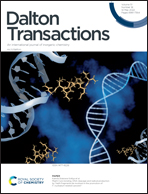Preparation of a bis-Schiff base immobilized mesoporous SBA-15 nanosensor for the fluorogenic sensing and adsorption of Cu2+†
Abstract
An inorganic–organic chemosensing material (MS-NSP) was developed by anchoring the bis-Schiff base fluorophore onto the channel surface of a SBA-15 mesoporous silica surface with a quaternary ammonium linker. The mesostructure, morphology, and spectral features of MS-NSP were systematically described. The nanohybrid could be implemented as a multifunctional fluorescent nanosensor for Cu2+ ions. A good linearity was observed over the concentration range from 0 to 4 mM, and the lower Cu2+ detection limit by MS-NSP was found to be 0.19 μM. Additionally, the fluorescence response of MS-NSP was remarkably specific for Cu2+ ions compared to other competitive ionic species. Moreover, the MS-NSP can also be utilized as an adsorbent for the effective elimination of Cu2+ from an aqueous solution. The kinetic features of adsorption were well described by the pseudo-second-order model and the sorption isotherm was in agreement with the Langmuir model. The theoretical maximum adsorption amount of Cu2+ ions was determined at 58.5 mg g−1. Finally, the interaction of MS-NSP and Cu2+ was investigated using theoretical calculations. Overall, the material in the present study is useful for both the sensitive detection and effective extraction of Cu2+ ions.


 Please wait while we load your content...
Please wait while we load your content...